The Suffrage Cause and
Bryn Mawr - More Speakers
Carrie Chapman Catt (1859-1947)
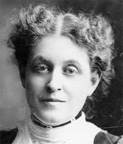 Carrie
Chapman Catt was one of the most widely known activists in both the national
and international suffrage campaigns. She served as president of the NAWSA for
two separate terms, first from 1900-1904 (succeeding Susan B. Anthony) and again
after Anna Howard Shaw's retirement in 1915. Catt was the NAWSA president when
the federal amendment was ratified on August 26, 1920. Catt was extremely active
in the international suffrage movement as well as the American campaign. She
helped found the International Woman Suffrage Alliance (IWSA) in 1902 at the
34th annual convention of the NAWSA in Washington, D.C., and was president from
1904 to 1923. The organization eventually represented thirty-two different countries.
Carrie
Chapman Catt was one of the most widely known activists in both the national
and international suffrage campaigns. She served as president of the NAWSA for
two separate terms, first from 1900-1904 (succeeding Susan B. Anthony) and again
after Anna Howard Shaw's retirement in 1915. Catt was the NAWSA president when
the federal amendment was ratified on August 26, 1920. Catt was extremely active
in the international suffrage movement as well as the American campaign. She
helped found the International Woman Suffrage Alliance (IWSA) in 1902 at the
34th annual convention of the NAWSA in Washington, D.C., and was president from
1904 to 1923. The organization eventually represented thirty-two different countries.
Although M. Carey Thomas was in contact with Catt on numerous occasions from
1901 onwards, Catt did not come to Bryn Mawr until 1921, when she gave the first
set of lectures in honor of Anna Howard Shaw. To launch the series, Thomas arranged
to have Catt address the campus in five large and lavish meetings in the gymnasium
(now the Campus Center). Thomas was very explicit as to the type of content
she hoped Catt would include in her speeches:
The following suggestion for lectures is of course entirely subject to your
revision. Mrs. [Caroline McCormick] Slade and I had very little time to talk
them over and you have probably seen her since but I think that we both felt
that a course of lectures addressed to new citizens would be of great interest.
It seems to me that the historical development of government was treated more
or less well in connection with the fight for suffrage but that the actual
conditions of practical politics were necessarily left until women got the
vote. In political discussions with even the most intelligent of the Bryn
Mawr students I find that they are very ignorant of conditions as they are
and rather inclined to take a romantic point of view.
Letter from M. Carey Thomas to Carrie Chapman Catt. M. Carey Thomas
Papers, Special Collections, Bryn Mawr College Library.
This exhibition would not be possible without the generosity of the estate of
Carrie Chapman Catt. Most of the photographs in the exhibition come from photo
albums in the Carrie
Chapman Catt Papers (Special Collections, Bryn Mawr College Library). The
albums contain approximately 815 photographs and a limited amount of printed matter,
mostly newspaper clippings, documenting the history of international woman's suffrage.
These materials and others related to the suffrage movement were a gift to Bryn
Mawr College in 1947.
Maud Wood Park (1871-1955)
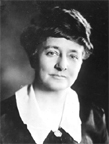 Maud Wood Park (Radcliffe College '98) was the founder of the National College
Equal Suffrage League (NCESL). Park started branches of the NCESL in thirty
different states, and can be credited for inspiring the establishment of Bryn
Mawr's chapter during her campus lecture in the spring of 1907.
Maud Wood Park (Radcliffe College '98) was the founder of the National College
Equal Suffrage League (NCESL). Park started branches of the NCESL in thirty
different states, and can be credited for inspiring the establishment of Bryn
Mawr's chapter during her campus lecture in the spring of 1907.
The presence of Bryn Mawr's own student branch of the NCESL, and Thomas's status
in the organization and in women's education in general, meant that the most
renowned pro-suffrage speakers came to Bryn Mawr. Maintaining the prestige that
Susan B. Anthony's 1902 visit had established, the campus welcomed every NAWSA
president other than Elizabeth Cady Stanton; famous American and English pro-vote
leaders, both male and female; and even the most notorious of English radical
suffragists. Their visits and the chapter's activities were reported in campus
publications, particularly the Alumnae Quarterly, and discussed in alumnae
club meetings.
Jane Addams (1860-1935)
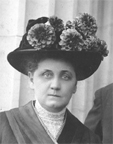 Jane
Addams founded Hull House in Chicago and was also highly active in the suffrage
world, serving as a first vice president of the NAWSA from 1911 to 1914. She
was one of the most frequent suffrage speakers on Bryn Mawr's campus and she,
like Catt, was engaged to present Anna Howard Shaw memorial lectures.
Jane
Addams founded Hull House in Chicago and was also highly active in the suffrage
world, serving as a first vice president of the NAWSA from 1911 to 1914. She
was one of the most frequent suffrage speakers on Bryn Mawr's campus and she,
like Catt, was engaged to present Anna Howard Shaw memorial lectures.
One of M. Carey Thomas's first major projects as President of the NCESL was
to organize a speaking tour by Jane Addams. Because of her national reputation,
Addams was considered an ideal person to recruit students for the NCESL. Her
tour was concentrated in the east, the area that caused the most trouble for
the suffrage movement and where the colleges, including some of the Seven Sisters,
were considered most entrenched in tradition.
On May 7, 1908, Thomas wrote to Addams, describing the effects of her talks:
It is impossible for me to tell you in the brief time at my disposal . .
. how greatly your lectures have helped the suffrage cause. We receive from
every quarter unanimous testimony to the conviction you brought home to your
hearers. People who have been unwilling to consider the subject before are
now warm believers in it. One of your most important disciples is now Professor
Vida Scudder of Wellesley. After your address at Bryn Mawr, twenty-nine students
who had been unconvinced capitulated; and it has been so everywhere. Miss
Garrett and I are delighted with the results. . . .
Max Eastman (1883-1969)
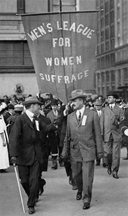 During
the suffrage era there were a large number of progressive men and men's organizations
working actively for the suffrage movement both in the U.S. and abroad. Their
participation in the campaigns is reflected in the visits of at least four prominent
men to Bryn Mawr's campus: Max Eastman, an American, and the British suffragists
Philip Snowden, Laurence Housman and F.W. Pethick-Lawrence.
During
the suffrage era there were a large number of progressive men and men's organizations
working actively for the suffrage movement both in the U.S. and abroad. Their
participation in the campaigns is reflected in the visits of at least four prominent
men to Bryn Mawr's campus: Max Eastman, an American, and the British suffragists
Philip Snowden, Laurence Housman and F.W. Pethick-Lawrence.
Eastman was a prominent Socialist and was associated with the culture of radical
artists and intellectuals in Greenwich Village. He helped found the Men's Equal
Suffrage League in 1910. Eastman was President of the Men's Equal Suffrage League
of New York State when he delivered his talk at Bryn Mawr in 1913, titled "Woman
Suffrage and Why I Believe in It." The Lantern reported that "the
result of his speech was a number of converts to woman suffrage." Eastman's
sister, Crystal, was a prominent member of the Congressional Union and the National
Woman's Party.
Antoinette Funk (d. 1942)
 By
1915 Antoinette Funk, a lawyer from Chicago, was the executive secretary of
the Congressional Committee of the NAWSA. She was part of the committee that
replaced Alice Paul's Congressional Union once it separated from the NAWSA.
Funk gave a December 3, 1915 speech, "The Best Arguments for Woman Suffrage,"
for the Bryn Mawr's College Equal Suffrage League.
By
1915 Antoinette Funk, a lawyer from Chicago, was the executive secretary of
the Congressional Committee of the NAWSA. She was part of the committee that
replaced Alice Paul's Congressional Union once it separated from the NAWSA.
Funk gave a December 3, 1915 speech, "The Best Arguments for Woman Suffrage,"
for the Bryn Mawr's College Equal Suffrage League.
Charlotte Perkins Gilman (1860-1935)
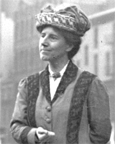 Charlotte
Perkins Gilman was an active and eloquent suffragist, making her a natural and
frequent speaker at NAWSA events. She later served on the advisory boards of
the Congressional Union and the National Woman's Party. Gilman spoke at Bryn
Mawr twice, once on "Women and Democracy" in 1911, and again in 1915
on "Women and Economics."
Charlotte
Perkins Gilman was an active and eloquent suffragist, making her a natural and
frequent speaker at NAWSA events. She later served on the advisory boards of
the Congressional Union and the National Woman's Party. Gilman spoke at Bryn
Mawr twice, once on "Women and Democracy" in 1911, and again in 1915
on "Women and Economics."
Helen Robertson '16 described Gilman's 1915 lecture in a letter home:
It was a very interesting lecture and if people were looking for an advocation
of sensational views in her they must have been disappointed. She is radical
enough to be sure, but she certainly wasn't sensational. Her idea was that
the human masculine and feminine were too different to live happily together
and the reason they were so different was the ages of economic dependence
of the woman on the man and that if women refused to be economically dependent
and went out and lived their own lives the world would be a better place.
That was only the outline and she filled in with a considerable amount of
sense and sentiment and also of course radical ideas like having specially
trained people look after the babies of people who weren't made to look after
their own. It was really quite interesting and she was a very good speaker.
Gilman wrote extensively on women's social and political issues and was recognized
by her contemporaries for her 1898 book, Women and Economics: A Study of
the Economic Relation Between Men and Women as a Factor in Social Evolution.
She also wrote a well-known book of suffrage songs and poems that was published
in 1911. Gilman is most widely known today for her 1892 feminist story, "The
Yellow Wallpaper."
 The
Suffrage Cause and Bryn Mawr - British Lecturers
The
Suffrage Cause and Bryn Mawr - British Lecturers 
 Carrie
Chapman Catt was one of the most widely known activists in both the national
and international suffrage campaigns. She served as president of the NAWSA for
two separate terms, first from 1900-1904 (succeeding Susan B. Anthony) and again
after Anna Howard Shaw's retirement in 1915. Catt was the NAWSA president when
the federal amendment was ratified on August 26, 1920. Catt was extremely active
in the international suffrage movement as well as the American campaign. She
helped found the International Woman Suffrage Alliance (IWSA) in 1902 at the
34th annual convention of the NAWSA in Washington, D.C., and was president from
1904 to 1923. The organization eventually represented thirty-two different countries.
Carrie
Chapman Catt was one of the most widely known activists in both the national
and international suffrage campaigns. She served as president of the NAWSA for
two separate terms, first from 1900-1904 (succeeding Susan B. Anthony) and again
after Anna Howard Shaw's retirement in 1915. Catt was the NAWSA president when
the federal amendment was ratified on August 26, 1920. Catt was extremely active
in the international suffrage movement as well as the American campaign. She
helped found the International Woman Suffrage Alliance (IWSA) in 1902 at the
34th annual convention of the NAWSA in Washington, D.C., and was president from
1904 to 1923. The organization eventually represented thirty-two different countries.






